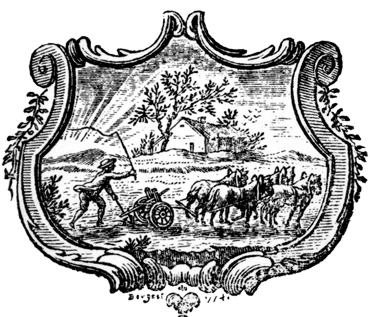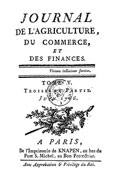| School | Troops | Resources |
The Physiocratic Journals

At their height during the French Enlightenment, the Physiocrats enjoyed access to two periodicals at different times to communicate and spread their ideas - the Journal d'agriculture, du commerce & des finances from 1765 to 1767, and the Éphémérides du citoyen thereafter from 1767 to 1776.
Contents
- Introduction to Physiocratic Journals
- Prelude.
- 1st Journal - The Journal de l'agriculture, du commerce et des finances
- 2nd Journal: - The Éphémérides du citoyen
- Contents of the Journal d'ACF
- Journal de l'agriculture, du commerce et des finances (Jul 1765-Dec 1766) (Physiocratic Phase)
- Journal de l'agriculture, du commerce et des finances (Feb 1767 - May 1770) (Colbertiste Phase)
- Journal de l'agriculture, du commerce et des finances (later phases)
- Contents of the Éphémérides du citoyen
- Éphémérides du citoyem, ou chronique de l'ésprit national (Nov 1765-Oct 1766) (Colbertiste phase)
- Éphémérides du citoyem, ou bibliothèque raisonnée des sciences morales et politiques (1767-1772) (Physiocratic Phase)
- Nouvelles Éphémérides Économiques, ou Bibliotheque raisonnée de l'histoire, de la morale et de la politique (1774-76) (Turgotian phase)
- Resources
I - Introduction to the Physiocratic Journals
Prelude
The burgeoning Enlightenment spirit of the 18th Century called forth a splurge of energy to bring practical information on arts and sciences to readers. Its first spate of energy was packaged in the form of dictionaries - the production of which became a veritable mania from the 1720s through 1740s. Among the economics-dedicated ones of this period was the celebrated Dictionnaire universel du commerce of Jacques Savary de Bruslons in 1723. Coming at the end of this era, and opening a new one, was the great Encyclopédie, ou Dictionnaire raisonné des sciences, des métiers et des arts, edited by Denis Diderot and Jean le Rond d'Alembert, which began to be published in 1751. It purported to go beyond mere definitions but provide whole systematic articles, incorporating all the latest scientific knowledge. The Neo-Colbertiste economist François Veron de Forbonnais contributed most of the economics-related articles in the early volumes of the Encyclopédie (volumes 3 through 5, 1753-55) and Jean-Jacques Rousseau was tapped for its important "Economie" article in v.5 (1755). But in the sixth (1756) and seventh (1757) volumes, the early Physiocrats - François Quesnay, the young Jacques Turgot and the Abbé Morellet, still in their pre-Physiocratic phase - contributed several articles to the Encyclopédie (albeit the bulk of the economic articles were now written by the indefatigable Charles-Étienne Pesselier, a tax farmer).
The Encyclopédie was suspended in 1759. By this time, Quesnay had devised his Tableau Economique, and Turgot had drafted several unpublished articles for the Encyclopédie, but neither had a venue to publish. So they turned to the reviews.
There were several French periodicals and journals dedicated, or open, to economic matters that cropped up during the Enlightenment age, the most notable of which were:
- Le Journal oeconomique (1751-72), Paris
- Le Nouvelliste oeconomique et littéraire (1754-61), The Hague
- Le Journal de commerce (1759-62), Brussels
- La Gazette du commerce (1763-83), Paris
- Journal de l'agriculture, du commerce et des finances (1765-74), Paris
- Les Ephémérides du citoyen (1767-72), Paris
- Les Nouvelles Ephémérides économiques (1774-76), Paris
The Journal oeconomique, ou, Mémoires, notes et avis sur l'agriculture, les arts, le commerce &tc., was arguably the first European review dedicated exclusively to economic topics - agriculture, industry and commerce. It was founded in Paris by Antoine Boudet, begun as a monthly in January 1751. Its April 1751 issue contained the famous article by René Louis de Voyer, Marquis d'Argenson with the famous story of Colbert and the merchants, and their "laissez nous faire" reply. (p.111). The Journal oeconomique ruled the roost for nearly two decades, folding only in 1772.
In 1754, seeing the potential market for a competing economics journal, the publishers of La Nouvelle bigarrure (f.1749) reset and renamed their publication Le Nouvelliste oeconomique et littéraire. The Nouvelliste was dedicated to collecting and reprinting articles from other journals and newspapers, French and foreign, about the rural economy, estate management, agriculture and developments in the mechanical arts. .
In 1759, another French economic review, the Journal de commerce was founded by the Abbé Roubaud and Le Camus, and entered into publication in Brussels. It was the third such dedicated publication in a now crowded market.
Competition did not hold for long. In 1761, the Nouvelliste folded, followed soon by the Journal du Commerce in 1762, leaving only the Journal oeconomique. But Roubaud and Le Camus re-launched their journal in Paris in January 1765, under a new title, the Gazette du Commerce. This one would last (with some interruptions) until 1783.
1st Journal - The Journal de l'agriculture, du commerce et des finances

In 1765, the Paris-edited Gazette du Commerce initiated the publication of a monthly journal, as a supplementary annex to the Gazette, collecting weightier theoretical and policy essays. This supplement was entitled the Journal de l'agriculture, du commerce et des finances (henceforth JdACF) The creation of the journal was encouraged by the controller-general Clément Charles François de Laverdy. The first issue of JdACF came out in July 1765, with Le Trosne (under his own name) taking up the cudgels for free trade against the Neo-Colbertistes. But things took a decided turn in September of that year when, under the influence of some well-wishers (probably Abbé Morellet or Trudaine), the young Pierre Samuel Dupont de Nemours, was appointed editor of the JdACF.
For the next year, from September 1765 until November 1766, the JdACF under the editorship of the young Dupont de Nemours became the veritable mouthpiece of the Physiocratic sect. Nearly all the great Physiocrats contributed regularly to it. The Physiocratic leader François Quesnay published numerous articles in it, under a variety of pseudonyms - "Mr. H", "Mr. N.", "Mr. de l'Isle", "Mr. Nisaque" (an anagram of his name) and even engaged in self-debates between his alternate personae (e.g. between Mr. H, an opponent, and Mr. N a proponent, of Physiocracy) Other contributors included Dupont de Nemours himself (as "Editeur" and "Mr. C"), the Marquis of Mirabeau (as "Mr. F"), Mercier de la Rivière (as "Mr. G"), Saint-Péravy (as "Mr.K") and Le Trosne (under his own name and as "Mr. M").
Annoyed at the Physiocratic splurge, the Abbé Baudeau, then still a conventional Colbertiste, launched his own journal in November 1765, the Ephémérides du citoyen (see below). When La Trosne published a pro-Physiocratic article in the Ephémérides, Baudeau reciprocated with a a counter-article in the JdACF (as "M. l'Abbé B***"). But the duel was short-lived - Baudeau himself would be converted to Physiocracy over the course of the next year.
In December 1766, the Gazette director Thomas-François de Grâce fired Dupont de Nemours, and appointed the Abbé Claude Yvon as the new editor of the JdACF. Yvon promptly shut out the Physiocrats and gave the journal over to the Neo-Colbertistes. Veron de Forbonnais ("Mr. ABCD") appeared regularly from 1767 onwards. In 1769, the journal added "des artes", and became known as Journal de l'agriculture, du commerce, des arts et des finances.
While the JdACF was in Neo-Colbertiste hands, the Physiocrats decamped to Baudeau's journal, Ephémérides du citoyen.
In 1770, Abbé Roubaud took over the Gazette and the JdACF from de Grâce. Under his editorship, from June 1770, Roubad re-oriented the JdACF back into the liberal camp, running alongside the Ephémérides for a while. Roubaud's famous defenses of the Physiocrats against their critics, notably against Galiani in 1770 and against Linguet in 1774, were published in the form of letters in the Gazette. Ultimately, it was a series of articles critical of the Maurepas administration led to suppression of the JdACF in December 1774. Roubaud went into exile.
The JdACF resumed publication in January 1778, under the editorship of Hubert Pascal Ameilhon. Blavet's French translation of Adam Smith's Wealth of Nations appeared serialized as columns in the JdACF from January 1779 to December 1780. Ameilhon stepped down in late 1781, when the editorship was taken up by the Abbé Fontenai, who renamed it Journal d'agriculture, commerce, artes et finances and edited it down to its last issue in December 1783. It was then absorbed by the Affiches, Annonces et Avis divers, which adopted subtitle Journal général de France, which later became its main title in 1785. A supplement devoted to agriculture was issued from 1787 to 1790.
(The contributor key for the JdACF for the years 1765-66 was revealed by Dupont de Nemours in his "Avertissement" of April, 1769 (p.x) of the Ephemerides du citoyen)
[entry in Hatin]
2nd Journal - The Éphémérides du citoyen

This journal was first founded as a biweekly sheet (modeled after the English Spectator) by Abbé Nicholas Baudeau in November 1765, under the title Éphémérides du citoyen, ou chronique de l'ésprit national. It was published every Monday and Friday, from November 4, 1765 to October 31, 1766. It began as a Neo-Colbertiste response to the Physiocrat-dominated Journal d'agriculture, du commerce et des finances (JdACF). When Le Trosne published an article in the Éphémérides promoting free trade, Baudeau reciprocated by publishing an article in the JdACF. This opened up a debate with Dupont de Nemours , editor of the JdACF. Baudeau eventually met personally with Dupont to discuss the issues, and was soon converted to Physiocracy himself.
When Dupont was dismissed and the JdACF taken over by Colbertistes in December, 1766, Baudeau reformatted his own journal, which began appearing as a monthly in January 1767 under the title Éphémérides du citoyen, ou bibliothèque raisonnée des sciences morales et politiques. The Abbé Baudeau stepped down as editor a year later, and appointed Dupont de Nemours as editor of the Éphémérides from May 1768. After Baudeau was called to Poland on ecclesiastical affairs in late 1768, Dupont de Nemours became also the official director from January 1769.
The Éphémérides du citoyen became the new Physiocratic journal, and the Physiocrats were once again regular contributors under a new set of pseudonyms: François Quesnay (as "Mr. A" or "Alpha"), Marquis of Mirabeau (as "Mr. B"), Jacques Turgot (as "Mr.C" or "Mr.X"), Dupont de Nemours (as "Mr. H"), Abbé Baudeau (as "Mr.L" or "L.B."), Abbé Roubaud (as "Mr. G" or "Mr. R"), Saint-Péravy (as "Mr. Q"), Vauvilliers (as "Mr.Y").
According to Dupont de Nemours, Mercier de la Rivière (Mr. G in JdACF), La Trosne (Mr. M in JdACF) and unknown (Mr. L in JdACF, Abeille?) did not contribute to the Éphémérides (at least not prior to April 1769).
The Éphémérides du citoyen continued publication until March 1772, when it was suppressed by royal order.
In late 1773, Abbé Nicholas Baudeau having returned from abroad, launched a new journal under the title Nouvelles Éphémérides économiques, ou bibliothèque raisonnée de l'histoire, de la morale et de la politique. This new journal ran from December 1773 to June 1776, through the duration of the Turgot administration.
HET
|
|
Resources
|
All rights reserved, Gonçalo L. Fonseca
